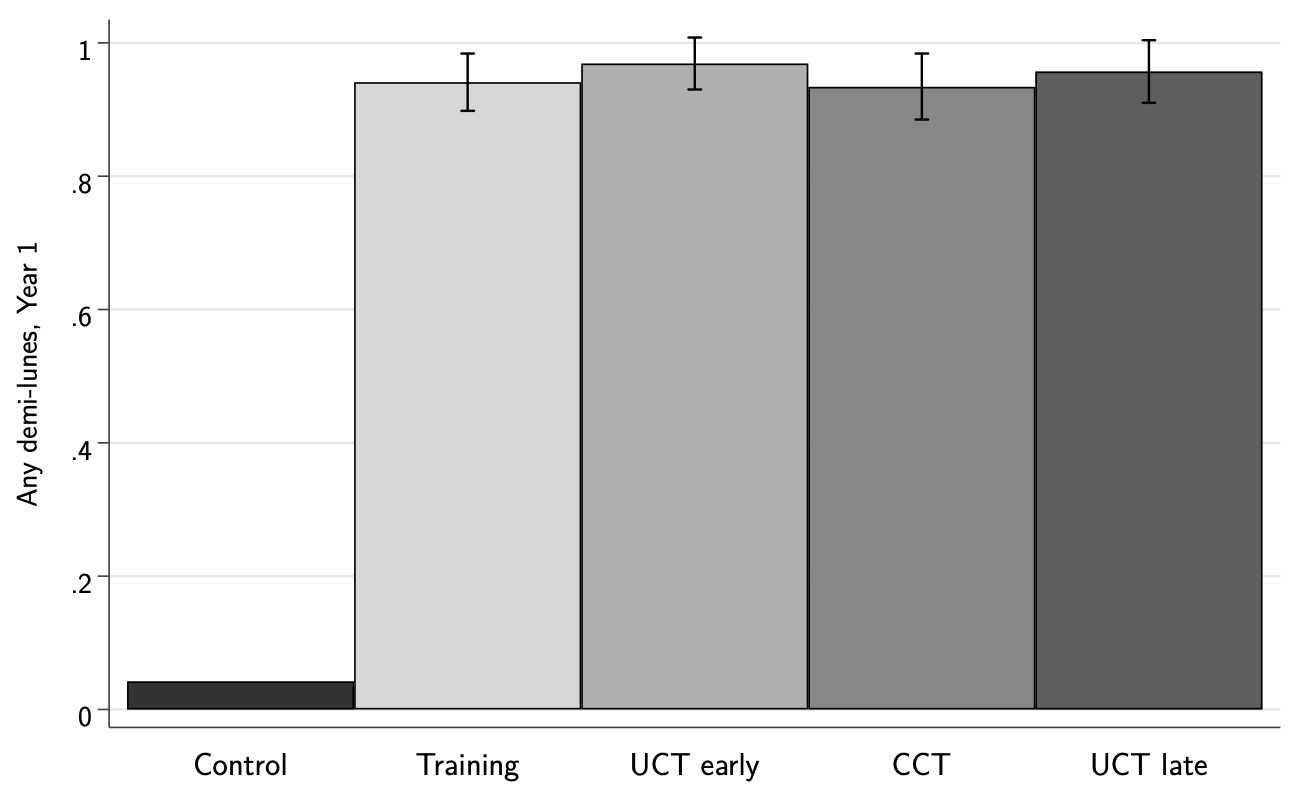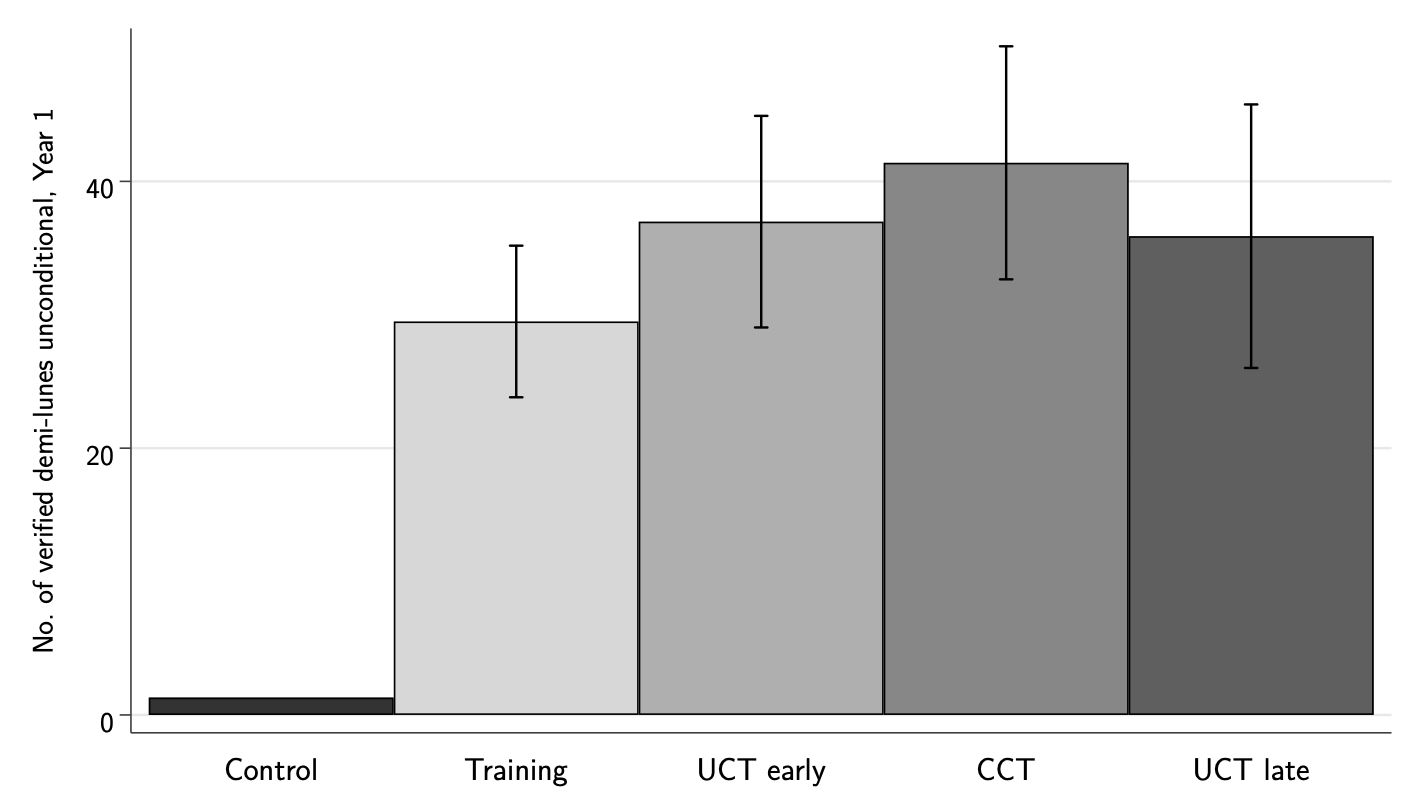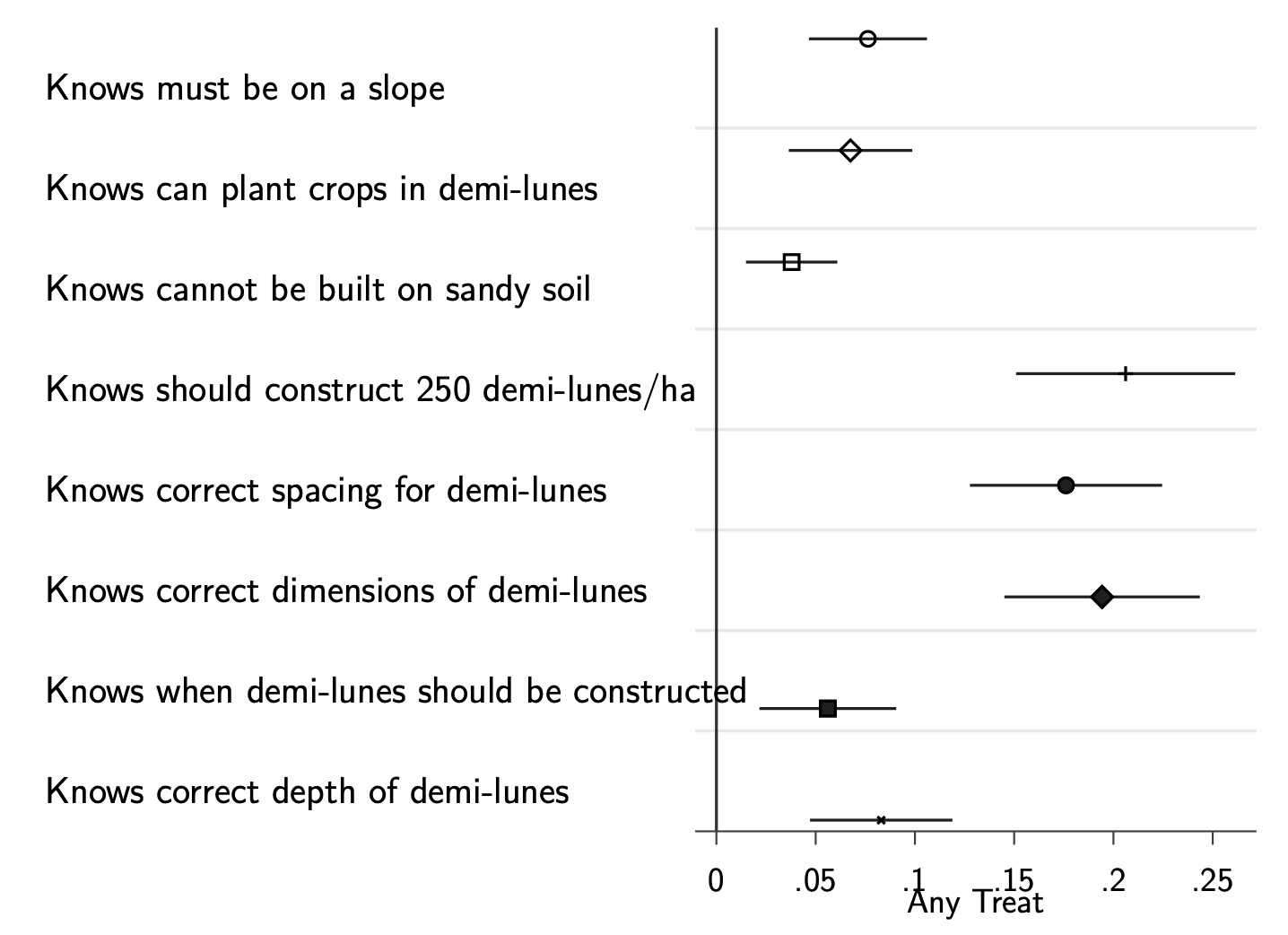
A simple training increased adoption of an agricultural technology by over 90%, with persistent improvements in agricultural production and land use
Approximately 50% of farmland in Sahelian West Africa suffers from nutrient depletion and poor soil fertility (Scherr 1999). Small-scale farmers in West Africa have traditionally dealt with poor rains and degraded soils by shifting into extensive agriculture, in other words, by bringing more land into production. However, high population density has resulted in shorter fallow periods, and reduced the availability of arable land (Warren et al. 2001), with climate change exacerbating these challenges.
Sustained yield improvements in the Sahel therefore require intensive agricultural practices to reduce farmers’ exposure to rainfall risk, namely, techniques that increase the level and duration of water stored within the soil and replenish soil nutrients. Rainwater harvesting techniques, which capture rainfall and reduce runoff, are a compelling option. Over the past few decades, millions of dollars have been spent to encourage the adoption of rainwater harvesting techniques.
Despite these investments, sustained levels of adoption of rainwater harvesting techniques remains low (Mekdaschi Studer and Liniger 2013; author’s calculations). This could be due to liquidity constraints – rainwater harvesting techniques require construction at a time when cash is constrained – or the timing of costs and benefits, since rainwater harvesting techniques require upfront costs in exchange for medium-term benefits. Another notable challenge, however, is information. Do farmers know about rainwater harvesting techniques? Do they know how to construct them? And do they know the costs and benefits?
Assessing the effect of information, with and without cash transfers
In an effort to address information constraints, a number of studies have assessed the impact of information on the adoption of agricultural technologies – including rainwater harvesting techniques – by using trainings, social networks, and extension and information campaigns (Magruder 2018, Macours 2019). While these results are promising, past evaluations of training find relatively small effects. This could be for several potential reasons:
- Some agricultural technologies are not profitable, at least for a majority of the farmers.
- Adoption of some technologies may be constrained by other input markets, such as labour.
- There may be other substitutes to the technology, so the marginal benefit is small.
- In many cases, the key constraint is not information – it is access to credit or something else.
Motivated by these questions and hypotheses, in our research (Aker and Jack 2022), we study how different interventions, including training and cash transfers, affect adoption of one rainwater harvesting technique – demi-lunes – in rural Niger. Following a pilot study, we worked with the Ministry of Environment and a research partner to implement these interventions.
Across 180 villages in one region in Niger, we randomly assigned villages to one of four interventions or a control:
- The control group did not have interventions over a three-year period.
- The first treatment group received a training.
- The additional treatment groups received the training plus a cash transfer: (i) an unconditional cash transfer before adoption (UCT-early), (ii) a conditional cash transfer (CCT), or (iii) unconditional cash transfer after adoption (UCT-late).
Training drives adoption of demi-lunes
The interventions were implemented during the first project year (2018), and we collected follow-up data for three years. We measured the impact of these interventions on a range of outcomes – including adoption, labour usage, agricultural production and land usage.
Our study found that a simple, one-day training significantly increased farm households’ adoption of demi-lunes relative to the control. Households in all of the treatment arms – training or training plus cash transfers – increased their likelihood of adopting the technology by over 90 percentage points, meaning that almost all farmers adopted at least one demi-lune.
Figure 1 Demi-lune adoption
Panel A

Panel B

Note: This graph shows the extensive (Panel A) and intensive (Panel B) margins of adoption in the short-term. The data were collected in the first year, several months after the training and cash transfers.
In the first year, farmers adopted an average of 36 demi-lunes, with slightly more in the arms that received upfront unconditional cash transfers and conditional cash transfers. Over time, we found that farmers adopted additional demi-lunes, but not as many as during the first year. The level of adoption across treatments converged over time – i.e. by year three, the level of adoption in the training-only arm was the same as in the arms that received cash transfers in addition to training. Adoption of the technology also had downstream impacts on agricultural production, land use, and asset ownership. Taken together, this suggests that the information was the main barrier to adoption, rather than liquidity constraints or low short run benefits from the technology.
'Awareness' is not the same as knowing how to implement the technology
What explains these results? Overall, we find that a majority of households were aware of the technology at baseline, but may not have known the necessary technical details (Figure 2) – such as the quantity, spacing, and dimensions of demi-lunes. What mattered for adoption was learning how to adopt, rather than learning about the technology. This is confirmed by what we observed in a ‘spillover sample’ – households in villages where a training occurred, but who were (randomly) not included in the training. These households constructed some additional demi-lunes, but not at the same level as the trained households. In addition, their knowledge of technical details did not improve – which suggests that training participation was necessary for the transfer of technical knowledge.
Figure 2 Technical knowledge

Note: This graph shows the likelihood of each respondent answering correctly on a demi-lune ‘test’ as compared with the control.
Policy implications: Training is a highly cost-effective intervention
Our results have a number of implications for understanding whether and how a simple training can influence farmers’ decisions, and their agricultural outcomes, in a resource-constrained setting.
Our evidence suggests that training alone can change behaviour and agricultural outcomes. The fact that we observe modest increases in adoption in the spillover group, but no increase in technical knowledge, suggests that learning from others does happen, but is less effective than participation in the training. We also note that training may have encouraged adoption via non-informational channels, such as motivation or salience.
Given the magnitude of the impacts across years, and the sustained results on agricultural production and land use patterns, these results are highly cost-effective. Relative to the cash transfers, which cost US$20 per farmer, the training intervention cost only $9 per farmer, and was highly cost effective. To put these costs in perspective, they imply $0.30 per demi-lune adopted, and $0.45 per dollar of agricultural output. These estimates omit the additional impact of training spillovers.
The next generation of training programmes would benefit from further experimentation, with scalability and replicability in mind. Specifically, costs could be lowered by training a larger number of farmers within the village, using phone calls and remote sensing to monitor adoption, and by doing trainings on different rainwater harvesting techniques, so that farmers can choose which ones to adopt.
References
Aker, J C and K Jack (2022), “Harvesting the rain: The adoption of environmental technologies in the Sahel”, NBER Working Paper No. 29518.
Macours, K (2019), “Farmers' demand and the traits and diffusion of agricultural innovations in developing countries”, Annual Review of Resource Economics 11: 483-499.
Magruder, J R (2018), “An assessment of experimental evidence on agricultural technology adoption in developing countries”, Annual Review of Resource Economics 10: 299-316.
Scherr, S J (1999), Poverty-environment interactions in agriculture: Key factors and policy implications, United Nations Development Programme.
Warren, A, S Batterbury and H Osbahr (2001), “Sustainability and Sahelian soils: Evidence from Niger”, Geographical Journal 167(4): 324-341.
Mekdaschi Studer, R and H Liniger (2013), Water Harvesting: Guidelines to Good Practice, Centre for Development and Environment (CDE), Rainwater Harvesting Implementation Network (RAIN), MetaMeta and The International Fund for Agricultural Development (IFAD).


